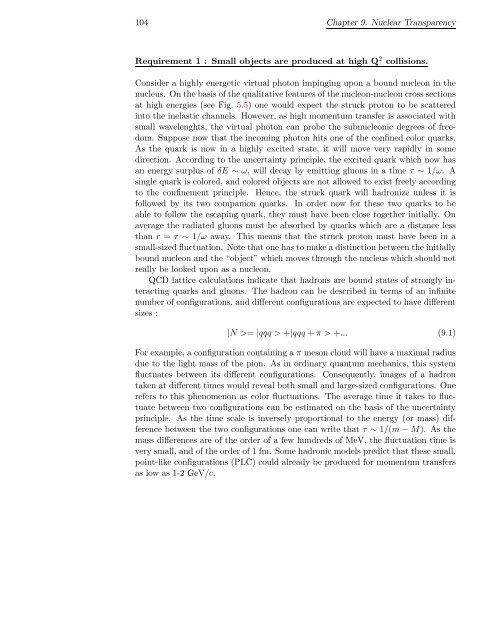Download Thesis in Pdf Format - Theoretical Nuclear Physics and ...
Download Thesis in Pdf Format - Theoretical Nuclear Physics and ...
Download Thesis in Pdf Format - Theoretical Nuclear Physics and ...
Create successful ePaper yourself
Turn your PDF publications into a flip-book with our unique Google optimized e-Paper software.
104 Chapter 9. <strong>Nuclear</strong> Transparency<br />
Requirement 1 : Small objects are produced at high Q 2 collisions.<br />
Consider a highly energetic virtual photon imp<strong>in</strong>g<strong>in</strong>g upon a bound nucleon <strong>in</strong> the<br />
nucleus. On the basis of the qualitative features of the nucleon-nucleon cross sections<br />
at high energies (see Fig. 5.5) one would expect the struck proton to be scattered<br />
<strong>in</strong>to the <strong>in</strong>elastic channels. However, as high momentum transfer is associated with<br />
small wavelenghts, the virtual photon can probe the subnucleonic degrees of freedom.<br />
Suppose now that the <strong>in</strong>com<strong>in</strong>g photon hits one of the conf<strong>in</strong>ed color quarks.<br />
As the quark is now <strong>in</strong> a highly excited state, it will move very rapidly <strong>in</strong> some<br />
direction. Accord<strong>in</strong>g to the uncerta<strong>in</strong>ty pr<strong>in</strong>ciple, the excited quark which now has<br />
an energy surplus of δE ∼ ω, will decay by emitt<strong>in</strong>g gluons <strong>in</strong> a time τ ∼ 1/ω. A<br />
s<strong>in</strong>gle quark is colored, <strong>and</strong> colored objects are not allowed to exist freely accord<strong>in</strong>g<br />
to the conf<strong>in</strong>ement pr<strong>in</strong>ciple. Hence, the struck quark will hadronize unless it is<br />
followed by its two companion quarks. In order now for these two quarks to be<br />
able to follow the escap<strong>in</strong>g quark, they must have been close together <strong>in</strong>itially. On<br />
average the radiated gluons must be absorbed by quarks which are a distance less<br />
than r = τ ∼ 1/ω away. This means that the struck proton must have been <strong>in</strong> a<br />
small-sized fluctuation. Note that one has to make a dist<strong>in</strong>ction between the <strong>in</strong>itially<br />
bound nucleon <strong>and</strong> the “object” which moves through the nucleus which should not<br />
really be looked upon as a nucleon.<br />
QCD lattice calculations <strong>in</strong>dicate that hadrons are bound states of strongly <strong>in</strong>teract<strong>in</strong>g<br />
quarks <strong>and</strong> gluons. The hadron can be described <strong>in</strong> terms of an <strong>in</strong>f<strong>in</strong>ite<br />
number of configurations, <strong>and</strong> different configurations are expected to have different<br />
sizes :<br />
|N >= |qqq > +|qqq + π > +... (9.1)<br />
For example, a configuration conta<strong>in</strong><strong>in</strong>g a π meson cloud will have a maximal radius<br />
due to the light mass of the pion. As <strong>in</strong> ord<strong>in</strong>ary quantum mechanics, this system<br />
fluctuates between its different configurations. Consequently, images of a hadron<br />
taken at different times would reveal both small <strong>and</strong> large-sized configurations. One<br />
refers to this phenomenon as color fluctuations. The average time it takes to fluctuate<br />
between two configurations can be estimated on the basis of the uncerta<strong>in</strong>ty<br />
pr<strong>in</strong>ciple. As the time scale is <strong>in</strong>versely proportional to the energy (or mass) difference<br />
between the two configurations one can write that τ ∼ 1/(m − M). As the<br />
mass differences are of the order of a few hundreds of MeV, the fluctuation time is<br />
very small, <strong>and</strong> of the order of 1 fm. Some hadronic models predict that these small,<br />
po<strong>in</strong>t-like configurations (PLC) could already be produced for momentum transfers<br />
as low as 1-2 GeV/c.















